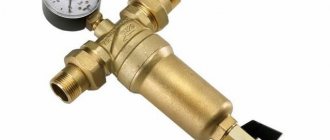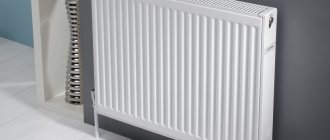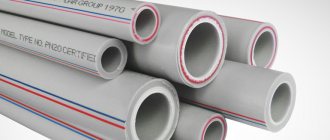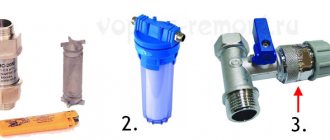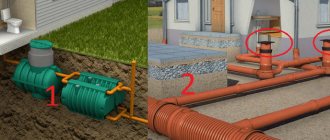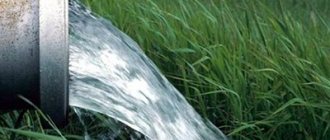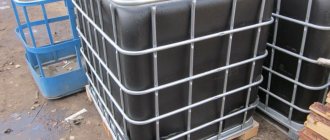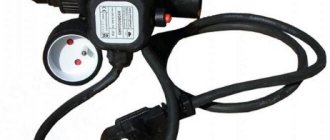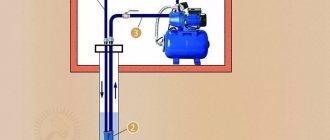In the absence of a centralized water main, residential building owners have to solve the water supply problem themselves by digging wells or drilling wells. Often, owners are faced with the problem of a small flow rate (volume of incoming water) of a source, for the exit from which a storage tank for water supply is used.
In order to effectively provide a home with water using a storage tank, the owner will have to solve a number of difficult problems in choosing a tank, its installation location, additional pumping equipment and automation devices, and connection diagrams. In order to avoid making critical mistakes, you should carefully study all the information on the use of storage tanks in autonomous water supply systems.
Rice. 1. Plastic storage tanks
When is a storage tank needed?
For residents of city apartments, a stable water supply with constant pressure seems to be something that is taken for granted, something that is not worth even thinking about.
But for residents of cottage and dacha settlements, this issue is not always easily resolved.
It’s good if there is a reliable and accessible source of water – connect a pumping station to it and use it to your heart’s content.
But quite often the water supply conditions are not so ideal.
Here are typical situations:
- the house is connected to a centralized water supply, but water is not supplied all the time, but only several times a day;
- an autonomous water supply is organized on the site, but the well or well has insufficient productivity and quickly becomes empty;
- Water is pumped into the house, but the electricity is often cut off.
Using water supply under such circumstances is a real torment: when water is not needed, it is there; as soon as the need arises, you won’t squeeze out a drop. This is where a storage tank comes in handy, acting as a battery. Its function is quite simple: during periods of minimal water consumption, it will slowly stock up on water, and during hours of maximum consumption, it will supply it to the water supply network.
In a suburban area you cannot do without a well - water supply is necessary for household needs and watering the garden. Types of drilling and well construction - design technology, which determines the depth and types of well construction with your own hands.
We’ll look at which pump to choose for a well for a dacha and country house here.
And here https://aquacomm.ru/vodosnabzenie/zagorodnyie-doma-v/avtonomnoe-vodosnabzhenie/istochniki/tehnologiy-bureniya-skvazhin.html all about the features of water well drilling technologies. Types of wells and drilling methods: rotary, auger and others.
Criterias of choice
When determining the required volume of the tank, the number of residents of the house and the number of water intakes that are capable of simultaneous consumption of liquid from the tank are taken into account. For example, a 20-30 liter battery can meet the needs of a family of 3-4 people. The productivity of pumping equipment should be approximately two cubic meters per hour.
The larger the volume of the hydraulic tank and the lower the water consumption, the less often the automation starts the pumping equipment. More than six starts per minute will result in a 20 percent increase in supercharger wear. When running more than ten times per minute, the wear rate increases by 30–40 percent. Also, small tanks offer almost no protection against water hammer.
Hydraulic tanks can be installed in two positions: horizontal or vertical. If space allows, purchase the first option. If there is a shortage of space, a vertical device is chosen.
Pay attention to the material of manufacture. Steel tanks are more reliable because plastic is prone to deformation. The presence of a membrane protects the metal walls from corrosion. But steel structures are more difficult to install due to their significant mass.
Water supply system for a private house with a storage tank - diagram
There are two methods of connecting a storage tank to a water supply system - with an upper and lower position.
Top mounted
The tank is installed on the second floor of the house or in the attic. Water towers in villages and small towns operate on the same principle. This option has the following advantages:
- Water flows to water collection points by gravity without the use of a pump, while the water supply system is energy-independent (can operate without electricity)
- The container is easy to install and maintain.
A caveat should be made: although the water flows by gravity, one should not expect strong pressure. As you know, a height difference of 10 m creates a pressure of 1 atm. Thus, if you place a storage tank in the attic of a two-story house with ceilings 3 m high, then the water pressure in the tap on the first floor will be approximately 0.6 atm, and this is without correction for the hydraulic resistance of the pipeline. On the second floor the pressure will be half as much.
Cumulative water supply scheme with two tanks
It makes no sense to install a Charcot shower with such a water supply system, but for a country house it is quite suitable.
A significant drawback of this scheme is that the storage capacity takes up useful space. After all, the attic could be turned into an attic or used to store some things or seasonal equipment. As an alternative solution, you can suggest installing the tank on a special overpass outside the house, but this is purely a summer option.
To use water in winter, you will have to install electric heating and insulation not only of the tank itself, but also of the pipelines leading to and from it.
Bottom mounted
This option is chosen by those who want to use all available space with maximum efficiency.
With this scheme, the storage tank is buried in the ground. On a half-meter layer of soil, which is sprinkled on the container, you can grow flowers or vegetables, so that not a single square meter will be wasted.
In this case, the dimensions of the tank are not limited in any way.
Obviously, this option is also not perfect. First of all, a pumping station will have to be introduced into the water supply scheme, without which water will not get into the tap or washing machine.
The second point: a container located underground is difficult to repair and clean. And lastly: in order to minimize the impact of frost heaving forces, the soil above the tank will have to be insulated.
Storage tank dug into the ground
Features of underground installation:
- The plastic tank must have a round shape or stiffeners, otherwise a concrete shell will need to be built around it.
- It is necessary to provide holes in the upper part for inspection and cleaning.
The tank should be installed with a slope of up to 15 degrees, so that sediment accumulates on one side just under the hatch.
Where to begin?
The arrangement of water supply in an automatic or semi-automatic mode begins with planning and project development and ends with periodic maintenance. At the first stage, it is important to analyze:
- What is the source of water supply (well, well)?
- What plumbing fixtures are planned to be installed in the house (number of toilets, sinks, bathtubs, showers, swimming pools)?
- What problems should the water supply system solve (dependence on electricity, minimum water supply, ensuring stable pressure on all floors, etc.)?
- Where is the equipment planned to be installed (in the technical room or outside the house)?
To ensure uninterrupted operation, it is important to use storage tanks that are needed to store water. A reserve supply is important in emergency situations, such as when the power goes out temporarily. This is the second advantage of installing storage tanks.
Storage tank volume
When calculating the volume of a storage tank, two factors are taken into account:
- Water consumption in a house or area : everyone’s water consumption is different, so it is impossible to recommend anything unambiguously in this case. For an approximate calculation, you can use average statistical data. So, in a house with all the amenities (except for a kitchen sink, toilet and bathroom, including a dishwasher and washing machine), approximately 170 - 200 liters of water are consumed per person per day. With a more modest regime - only for washing, drinking and cooking (for example, in a country house) - the needs are reduced to 60 - 80 l / day per person.
- “Operating schedule” and productivity of the water supply source : no matter how we calculate our needs, even two hundred or three hundred liters per person, a lot depends on how much water comes from the source. There is no reason to drag a cubic container into the attic if no more than 500 liters can be pumped into it per day. You can also do without a large tank if interruptions in water supply are short-term and a significant share of water needs is covered directly, without the “services” of a storage tank.
The storage tank is often confused with the hydraulic accumulator of pumping stations (PS). This is not entirely correct. Both devices perform a similar function, but the volume of the HC accumulator, which has a rubber bulb or membrane inside, is no more than 100 l (most often 25 - 50 l). It is needed only to prevent frequent starts of the pump, and cannot compensate for long interruptions in water supply.
Design
Storage tanks for water supply are made of food-grade stainless steel (steel grade - 12Х18Н10Т) or food-grade plastic.
The material must be of high quality, otherwise unwanted chemical compounds will get into the water, which is harmful to the health of people consuming this water.
Design Features:
- A float valve of the kind used in toilet tanks is installed on the inlet pipe. If water is pumped into the tank from your own well or well, a float switch for the pump is installed instead of a tap.
- In case of failure of the float mechanism, an overflow pipe connected to the sewer is cut below the inlet.
- It is also necessary to install a filter at the entrance. There are several varieties: mesh (mud collectors), cyclones and centrifugal filter pumps. The first group is used for relatively clean water, the other two – for highly polluted water. A strainer should also be installed on the outlet pipe. It is better if it is located at the entrance of the main pipe into the house immediately before the wiring.
- A level is inserted into a tank with opaque walls. It will help determine whether there is enough water, for example, for a washing machine.
- It is necessary to ensure that sediment can be removed. Underground containers, as already mentioned, are cleaned through a hatch located on top. Tanks intended for installation at the top are equipped with a drainage pipe that cuts into the very bottom.
- Filling the tank should be done through a diffuser - a shower head or garden watering can. This will prevent water from mixing with the bottom layer containing sediment.
- A ventilation pipe (blowhole) cuts into the container from above. It should be curved so that the inlet is directed downward. A mesh should be installed at the entrance to the ventilation pipe to prevent debris and insects from entering the tank.
The ventilation pipe must have a sufficiently large diameter. It is also necessary to ensure that its filter is not clogged with all kinds of debris, for example, poplar fluff. If you drain a tank without air, atmospheric pressure can flatten it like a tin can.
Water collection for technical needs
Have you ever thought that rainwater can be collected for technical needs using storage tanks and plastic pipes for water supply already known to you?
To do this, it is enough to install the tank above or below the ground and connect plastic pipes to it for water supply from the drains. An alternative to pipes is drainage trays. However, it is important to ensure that excess water is drained from the container.
Choose a tank material that is safe, durable, lightweight and does not require special care. Plastic tanks have these properties, take a closer look. When choosing polyethylene pipes for water supply, you avoid fakes. Thus, Europlast offers only high-quality and proven products that meet the requirements of GOST 18599-2001.
In the article, we gave general recommendations for organizing water supply at home using a container. For detailed information, as well as selection of the necessary equipment, please contact us. We will help in any situation.
Installation of water supply
The installation of the water supply network is carried out in stages.
If water is extracted from a well, a pump is installed on it.
Its type depends on the depth of the source:
- up to 8 m – surface pump;
- from 8 to 20 m – surface pump with a remote ejector;
- over 20 m – submersible pump.
The suction line of the surface pump must be equipped with a check valve. If a submersible pump is used, a check valve is installed on the pipeline leading to the house.
Storage circuit with pumping station and hydraulic accumulators
In automatic mode, the pump is turned on and off by coordinated signals of three elements:
- level sensor installed in the well;
- dry running protection relay;
- float switch installed in the storage tank.
Using a flexible reinforced hose with a diameter of 1" the pump is connected to a polyethylene pipeline (outer diameter - 32 mm) laid to the storage tank.
If the tank has a large volume and is installed on an interfloor ceiling, a flooring of thick boards should be laid under it, which will distribute the weight load over a large surface.
Water supply to the house from a well with a storage tank
Installation of the float valve is carried out in the following order:
- A washer is put on the valve shank, after which it is inserted into the inlet hole.
- Then, from the inside, they put on the shank: a stiffening plate, a second washer and a fixing nut.
- Now, from the outside, you need to screw the adapter to the shank, to which the supply pipeline will be connected.
- The float switch for the pump is installed in the same way.
When installed at the top, the tank remains connected to the sewerage system and water supply network. If the tank is located underground, it is necessary to install and connect a pumping station with a membrane accumulator. Like a well pump, the station must have dry-running protection, which will turn it off as soon as the tank is empty.
Connecting pipes from the caisson and tank to the house
Now let's move on to other elements of the autonomous water supply system. In addition to the pump or pumping station, storage or control tank, you will need:
- filters for water purification;
- pipes for internal and external installation;
- devices that ensure automatic operation of the system.
Filters
The selection of necessary filters depends on the quality of the water in your source. In some situations, water treatment stations are installed. However, to protect against mechanical impurities, filtration installations are necessary for all systems.
If the water is not very polluted, then we recommend installing a mesh filter due to the low cost of the product and its sufficient efficiency.
Price
The price level for storage tanks for water supply depends on their volume and material of manufacture.
A model with a volume of 200 liters, made of food-grade plastic, costs around 4,000 rubles.
A larger tank, for example, 700 liters, will cost the consumer approximately 8,000 rubles.
Containers made of stainless steel are much more expensive:
- volume 180 liters – 13,700 rubles;
- 635 liters – 30,500 rubles.
However, despite this difference in price, the majority of consumers prefer steel storage tanks.
The distribution of water pipes in a private house is installed after all construction work has been completed. Water distribution in a private house - external and internal distribution, installation of the system.
You can familiarize yourself with sanitary standards and requirements for organizing protective and security zones of water intake sources in this article.
Centrifugal and cyclonic filtration systems are used for contaminated waters.
Pipes
The service life of the entire system depends on the quality of the pipeline and its connection. In practice, 4 types of pipes are used to lay the main line. Let's take a closer look at each variety.
- Copper
Such pipes can easily withstand multiple pressure drops in the system and are resistant to corrosion and ultraviolet radiation. The only drawback is the price.
2. Steel
Durable, affordable, but susceptible to rust. And also the connection of such pipes is labor-intensive: the joint is either welded with subsequent protection of the weld, or a thread is cut at the end of each element.
3. Metal-plastic
The basis of such pipes is aluminum, coated on the inside and outside with a layer of polyethylene. They do not rust, do not form condensation, are not destroyed by ultraviolet radiation, and do not accumulate dirt and mineral deposits. However, they are deformed at low temperatures and heating above 95 degrees.
4. Plastic
Plastic pipes for water supply are the most popular due to their properties and easy installation. Let's consider 2 main materials: polypropylene (PP) and low-density polyethylene (HDPE).
Polypropylene pipes are light, durable, resistant to temperature changes, and are not susceptible to rust or other external influences. However, they do not bend, so connecting elements must be used to turn the line and drain the pipe.
HDPE pipes and fittings for water supply have the same advantages as polypropylene pipes, in addition they are also elastic - they can withstand external dynamic influences and water hammer. Service life is at least 50 years.
HDPE water pipes for cold water supply can be used when organizing automatic watering of a suburban area, equipping wells, and arranging fountains. You can select the required pipe yourself using the table.
For drinking water supply, choose products with a blue stripe.


